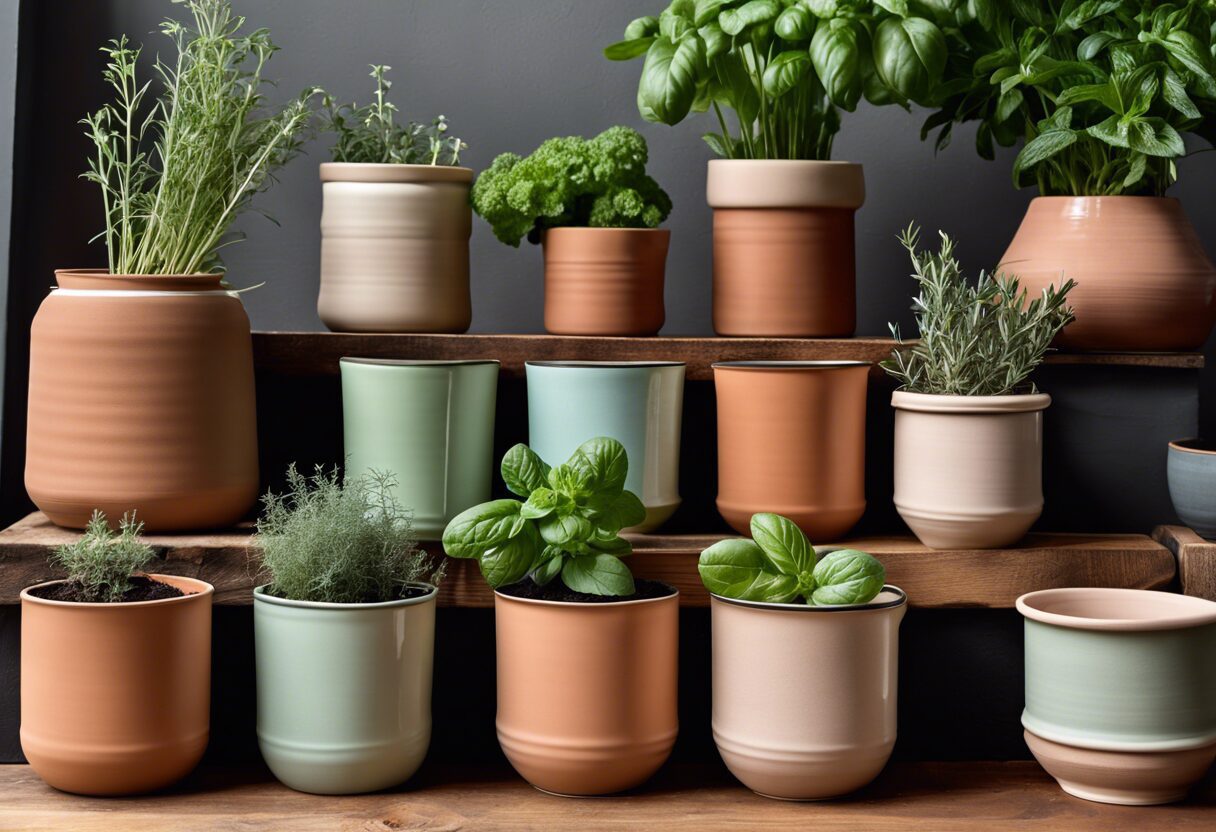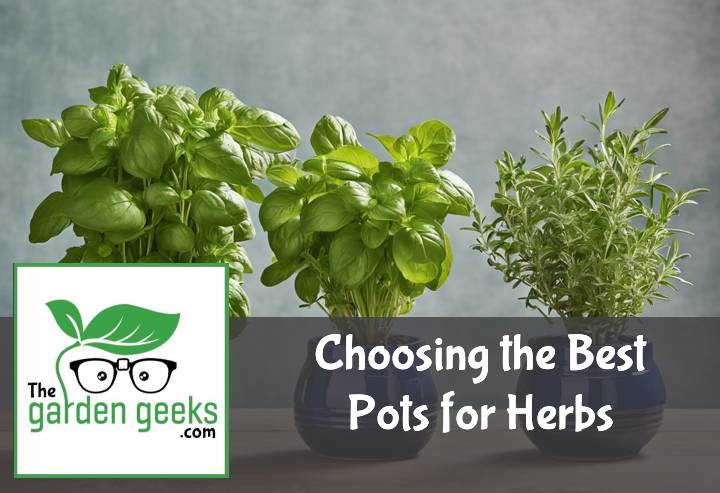Ever tried your hand at indoor gardening and ended up with wilting herbs despite your best efforts? I’ve been there, trust me. The secret lies in Choosing the Best Pots for Herbs. It’s not just about the soil or sunlight, but also about picking the right home for your green babies.
Choosing a pot might seem like an easy task, but it’s more than just going for the prettiest one on the shelf. You need to consider factors like size, drainage capabilities, and material. But don’t worry! We’re here to break it all down for you. Keep reading about Choosing the Best Pots for Herbs (With Examples).
Key Takeaways
- Terra cotta pots are excellent for herbs that prefer dry conditions, like rosemary and thyme.
- Self-watering pots are ideal for moisture-loving herbs such as basil and parsley.
- Metal pots can heat up and damage roots, so they’re not recommended.
- Ceramic or glazed pots work well for most herbs but require regular watering.
- Size matters: small pots for small herbs (like oregano), large pots for larger ones (like mint).
- Drainage is crucial to prevent root rot.

Why Choosing the Right Pot for Herbs Matters
Choosing the Best Pots for Herbs isn’t just about aesthetics. It’s a crucial factor that directly affects their growth and longevity. We’ll dive into how herb pot selection can make or break your herb garden in the sections below.
Impact on Herb Growth
The right pot for herbs can significantly impact their growth. The size of the pot, for instance, determines how much room the roots have to spread out. If you’re thinking “Size doesn’t matter,” think again! Your herbs might beg to differ.
Next up is material. You might be drawn to those shiny metal pots because they match your kitchen decor, but your herbs might not share your design sensibilities. Certain materials can affect temperature regulation and could stunt herb growth.
Lastly, let’s talk about drainage. No one likes soggy feet, especially not your herbs! Proper drainage in herb pots ensures that water doesn’t pool at the bottom, which could lead to root rot.
Influence on Herb Health and Longevity
Now onto how pots influence herb health and longevity. A well-chosen pot can provide ample root space for healthy growth. Imagine being stuck in a cramped apartment with no room to stretch – not fun, right? That’s exactly how your herbs feel in a too-small pot!
Moisture control is another key aspect of choosing herb pots. Overwatering is a common mistake among newbie gardeners (no judgment here!), but a good pot with proper drainage can help mitigate this issue.
In essence, finding the right balance between root space and moisture control is crucial in extending herb lifespan. So next time you go pot shopping, remember – it’s not just about what looks pretty on your windowsill!
Understanding Different Types of Pots


When it comes to choosing the best pots for herbs, there’s a smorgasbord of options. We’ve got terracotta, ceramic, plastic, and metal pots. Each has its own charm and quirks that can affect your herb’s growth.
Terracotta Pots
Terracotta pots are like the classic oldies in the world of gardening. They’re made from baked clay which makes them breathable – great news for your herbs’ roots! But hold your horses, they’re not perfect. The benefits of terracotta pots include their porous nature which allows excess water to escape, preventing root rot.
However, this same feature can be a drawback as it means they dry out quickly. So if you’re someone who forgets to water plants (no judgment here), these might not be your best bet. That’s the skinny on terracotta pots for herbs.
Ceramic Pots
Next up, we have ceramic pots. These beauties are heavier and less porous than terracotta ones. This means they retain moisture better – a big plus if you’re prone to forgetting watering duties!
But remember, with great power comes great responsibility! Ceramic pots can become too wet and cause root rot if not properly drained. So keep an eye out for that when considering the advantages and disadvantages of ceramic pots.
Plastic Pots
Plastic pots are like the millennials of plant containers – lightweight, versatile and affordable! They retain moisture well which is good for those forgetful waterers among us.
However, unlike their more natural counterparts (looking at you terracotta and ceramic), they don’t breathe well which can lead to overwatering issues. So while there are pros to using plastic pots for herbs, remember their cons too!
Metal Pots
Last but definitely not least, we have metal pots. These bad boys are durable and can add a sleek, modern touch to your herb garden.
But beware! Metal conducts heat which can lead to overheated soil in sunny spots. So while there are strengths of metal pots, don’t forget their weaknesses when choosing the best pots for herbs.



Factors to Consider When Choosing the Best Pots for Herbs
When it comes to herb pot selection, there’s more than meets the eye. It’s not just about aesthetics, but also practical factors like size, drainage capabilities, and material. These are crucial herb pot considerations that can make or break your herb garden.
Size of the Pot
The size of the herb pot plays a significant role in how well your herbs grow. Too small, and roots might get cramped. Too big, and they could drown in excess soil moisture.
Different herbs have different root systems and growth habits, so appropriate herb pot sizes vary. For instance, basil loves roomy pots while thyme prefers cozy quarters. So when you’re out there choosing herb pot size, remember – one size doesn’t fit all!
Drainage Capabilities
Ever heard of ‘drowning plants’? Well, it’s a thing! And it happens when pots don’t drain well. Good drainage in herb pots is essential for healthy roots and prevents waterlogging.
So how do you assess a pot’s drainage capabilities? Easy peasy! Look for multiple holes at the bottom or sides of the pot. No holes or just one? That’s a no-go zone for most herbs!
Material of the Pot
Last but not least, let’s talk about what your pots are made from – their material. Different herb pot materials have different effects on plant health and maintenance requirements.
For example, terracotta is breathable but dries out quickly – great for drought-tolerant herbs like rosemary but not so much for moisture-loving mint. On the other hand, plastic retains moisture longer but may need extra drainage holes drilled in.
In short: every material has its pros and cons. Choose wisely based on your herbs’ needs and your own maintenance preferences.
Examples of Best Pots for Specific Herbs
Choosing the Best Pots for Herbs can be a bit tricky. But don’t worry, we’ve got you covered! Let’s dive into some examples of herb gardening pots that are perfect for basil, mint, and rosemary.
Basil in Terracotta Pots
When it comes to growing basil, terracotta pots are your best bet. Why? Well, these pots are known for their excellent moisture control. Basil loves well-drained soil and terracotta does just that!
Plus, they’re great at temperature regulation too. They keep the roots cool during hot summer days. So if you’re thinking about growing basil in terracotta, go for it!
Mint in Ceramic Pots
Now let’s talk about mint. For this herb, ceramic pots take the cake. These pots have superb drainage capabilities which is super important because mint doesn’t like soggy feet!
Also, they offer ample space for the roots to spread out. So if you’re planning on mint in ceramic pots, you’re making a wise choice!
Rosemary in Plastic Pots
Last but not least, we have rosemary. This hardy herb thrives in plastic pots due to their durability and cost-effectiveness.
Plastic containers hold moisture longer than other materials which is beneficial as rosemary likes it dry between waterings. Plus, they’re lightweight and easy to move around.
So there you have it folks! When it comes to rosemary in plastic pots, it’s a match made in heaven!
Common Mistakes to Avoid When Choosing the Best Pots for Herbs
When it comes to choosing herb pots, many folks stumble into a few pitfalls. From size blunders to drainage disasters, let’s talk about these herb pot mistakes.
Overly Large or Small Pots
The first misstep is picking the wrong pot size. You see, herbs are like Goldilocks – they want their pots just right! Too big and the roots can’t reach the nutrients. Too small, and they’re all cramped up. So, remember, when it comes to herb pot size, balance is key.
Lack of Drainage Holes
Next on our list of boo-boos is forgetting about drainage. Herbs don’t like wet feet, folks! Without proper drainage holes in herb pots, your green buddies might drown or develop root rot. So make sure your pots have enough escape routes for excess water.
Wrong Material Choice
Lastly, we’ve got material mix-ups. Not all pots are created equal, you know? Some materials might retain too much moisture or heat which isn’t good for your herbs. So be mindful of the impact of pot material on herbs when choosing your next herb home!


To Wrap Up
In the herb pot world, size does matter! Like Goldilocks in the three bears’ house, your herbs need a pot that’s just right. Not too big, not too small – but perfectly balanced for their roots to breathe and spread.
So, when it comes to Choosing the Best Pots for Herbs remember our tips. Your herbs will thank you with lush growth and tantalizing flavors. Go forth and pot wisely!


